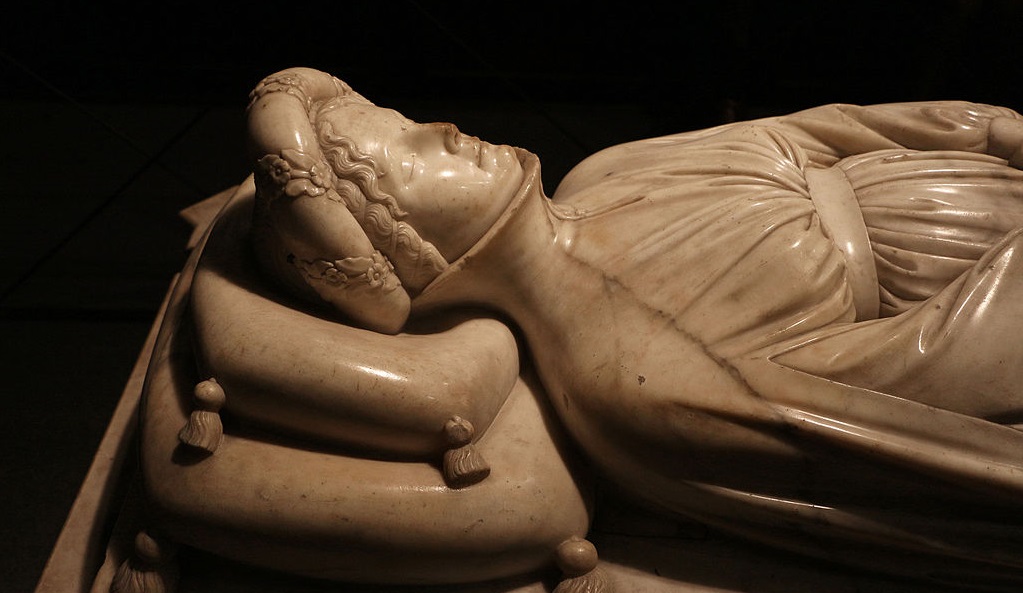Ilaria Del Carretto was the second wife of Paolo Guinigi of Lucca. Her sepulchre lies in Lucca’s Duomo San Martino and the tall Guinigi tower has a garden in the sky and is crowned with holm oak trees.
Her image wears a mantle and pelisse.
Many have come to gaze on her and marvel
At her grace and beauty, caught in marble—
An early renaissance sculptor’s masterpiece
Although Ilaria never rested here.
The tomb is empty yet its fame had spread.
Her tranquil pose, long after life had fled,
Convinces us that death should hold no fear
If we look beyond with hope that frees.
Yet should you walk a short way to her tower
And climb in silence, at a certain hour
You may see her smile beneath the trees
And, when you leave, you know that you are blest
While flights of angels sing her to her rest.
Lawrence Fray is a retired teacher living in New Delhi and Ranikhet, a hill station of North India, finally finding time to write poetry, short stories and music.















No rusted, twisted iron bars to see;
This sculpted marble tribute — mystery
Among the oaks, her spirit walks above
A clear expression of undying love.
Just lovely.
.
That’s a really lovely response.
I’m with Sally – a lovely poem indeed!
Two technical questions:
I liked your pairing of “marvel” with “marble”, but found myself wondering if it’s a rhyme in the strict sense of the word. Does the full syllable have to rhyme, or can its last sound suffice?
I also wondered about your use of “had” in the phrase “its fame had spread.”
Wouldn’t “has” have been more in line with the timing of your poem? Has the fame of the tomb not spread to us today?
Yes…has is probably better; I will amend. As for marble and marvel: it just seemed to work for this poem. I guess we have to take solace from the fact that we can bend rules a little to create atmosphere and effect.
I’m just grateful to have learned of what is for me a new icon of beauty. Thank you, Lawrence!
Look up “Guidarello Guidarelli”.
Very handsome even in death.
His tomb is called the tomb of 1000 kisses.
This was such a delicate piece…. literally transported me to the time she lived. Lovely indeed.
The last line of the sonnet is borrowed almost verbatim from Shakespeare, in the last scene of Hamlet. Such borrowings are OK, as long as they are few and far between.
“Marvel” and “marble” are a near-rhyme, and perfectly acceptable in traditional verse. What we have to avoid are off-rhymes or merely assonance-based rhymes, which are just the lazy man’s way to avoid rhyming at all.
It’s a nice sonnet.
Thank you. Yes, the last line is from the last act of Hamlet, but I thought it OK here as ‘flights’ connected with climbing the steps of the tower mentioned previously
Well, ‘marble’ is a really tricky word to rhyme.
The only true rhyme I can think of is ‘garble’, which just wouldn’t suit the subject matter.
So you either make do with a near-rhyme, or tuck ‘marble’ into the line and end the line a different word.
* So you either make do with a near-rhyme, or tuck ‘marble’ into the line and end the line with a different word.
Exactly that, MP: if one can’t find a proper rhyme, one should, if need be, change the whole line around until one finds a fully-rhyming end-word. When writing poetry, one should always find a way to do the right thing: the sacred discipline of poetry demands it.
Oh dear.
First we had “Michelangelo Buonarotti” instead of “Michelangelo Buonarroti”. (It still hasn’t been fixed.)
Now we have “Ilaria Del Caretta” instead of “Ilaria Del Carretto” and “Paola Guinigi” instead of “Paolo Guinigi”.
Why be so sloppy?
It’s just the nature of the beast. Not every Anglophone can transcribe good Italian well.
C. B., don’t limit yourself.
Dear M.P. Lauretta, my apologies for the typos. These are my fault. They should all be fixed now. Feel free to email [email protected] if I don’t respond quickly. I will try to be more careful with my Italian double consonants and endings. A second pair of eyes is always appreciated. Thank you for reading! -Evan
Dear Evan
I’m sorry if I overreacted, but to a native Italian speaker these things are almost painful.
This is because in Italian double consonants really do sound like doubles, and singles like singles (although it gets more complicated when you look at some dialects – but then, fun is often made of those).
The vowels are also unmistakeable and never blurred. While in English ‘per’ and ‘purr’ may sound the same, Italian vowels always retain their distinctive sounds.
And then, of course, there is Paolo Guinigi’s unintended sex change…
I promise, if I spot any more of these I will just email you.
ATB
M. P.
Just a lovely poem